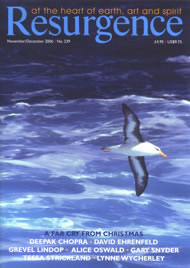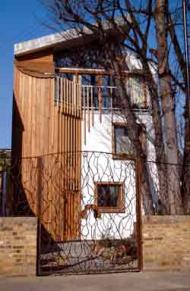THE QUALITY AND clarity of Will Anderson’s vision, intention and personality imbue his writing with insight, humour and honesty. The pages of the Diary are filled with clear information about his vision of a self-build urban eco-house from the project’s conception to its completion.
Initially written in the form of a regular feature in The Independent, the progress of the build gathered popularity and interest, encouraging the production of a book format. Diary entries cover a period of a year and a half, from 1st September 2004 to 1st March 2006.
With orderly chapters and comprehensive resource listings providing practical information with every topic, this is a veritable A–Z, from Artists to Zero Emission Developments. This creates a balanced and enjoyable read, incorporating the ‘What happens next?’ factor. Anderson shares his innermost thoughts and feelings with the reader, allowing involvement with his internal processes.
This is clearly a ‘we’ not ‘me’ project: “Tree House is a highly crafted building, built by a skilled team of craftspeople whose commitment to quality has kept the project in the realm of dreams rather than nightmares.” Every key person connected with the house, from builders to neighbours’ children, features in the book with cameo parts, making each player a star in her or his own right: not least, the sycamore that is the leading character in this unfolding drama.
The tree was already living on the plot of brownfield land in Clapham. Unusually, this large tree on a small building plot (150 sqare metres), was staying. Loved and wanted, totemically symbolic for a new era in building practices, it became the inspiration for the design of Tree House, masterfully worked by architect Peter Smithdale. Smithdale envisaged the timber-framed, high-tech, aesthetically pleasing, solar-fuelled, low-power house, now home to two men and four cats.
The three-storey townhouse with garden is designed and built to respect and enhance as much as possible the biodiversity created by the tree. This is notably exceptional in an urban environment, illustrating further that eco-houses can be recognisably stylish whilst harmonising with nature in a way that could be described as the ‘new modern’; going beyond the ‘comfort means consumerist’ paradigm.
Bill Dunster, designer of BedZED, the South London eco-housing development, and Peter Harper of the Centre for Alternative Technology also extol and exemplify the virtues of sustainable city dwelling; myth-busting that green must be rural. As Anderson puts it, “If ‘green living’ is all about sacrifice, forget it. We want more: more light, more comfort, more beauty, more health and more style.” This is from a man who now also eschews cars and aeroplanes. Well done, Will.
Barbara Tremain-Howard is a garden designer and freelance journalist, writing mainly about eco-building.








